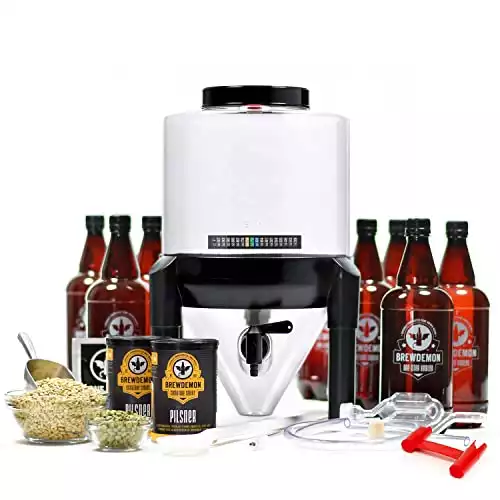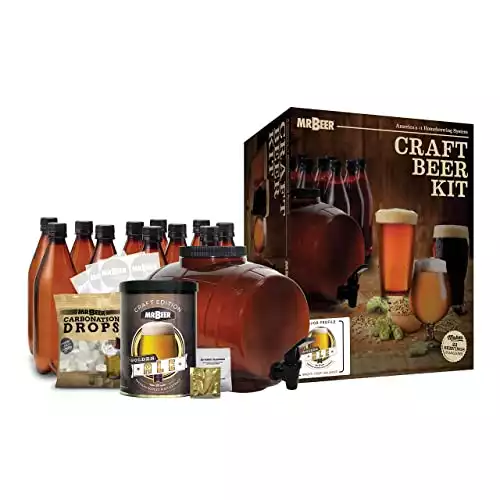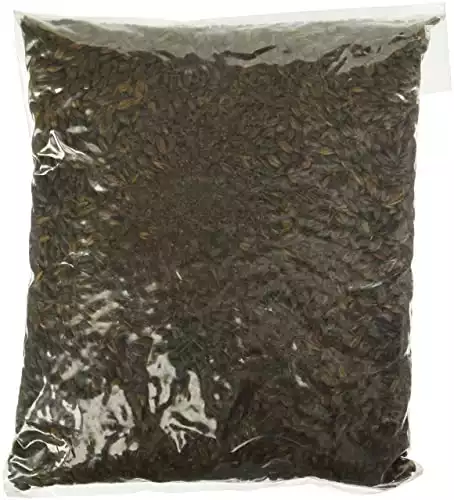The beer’s backbone is malt. In malted barley form, malts are the foundation for a beer’s mouthfeel, flavor, and color. They are also one of the three critical recipes that found their appellations in the 1516 German Beer Purity Law (the Reinheitsgebot ). As unsung heroes, these grains create an interactive platform for additives, yeast, and hops.
No matter if you’re an expert home brewer or just starting out, one of the most important factors of your brews is your brewing malts. There are so many different kinds of different brews. But which malts do you need for which brew?
These types of brewing malts guide will detail malts characteristics so that you know your malts, whether you are a brew fan thirsty for more beer knowledge or a homebrewer that wants to expand their style.
With that being said, homebrewers have a different variety of malts available than ever before. They are indispensable if these home brewers are looking to brew to style and use authentic ingredients.
One aspect of the all-grain brewing experience is learning about malted grain. Therefore, a serious all-grain homebrewer with an interest in a recipe formulation will find this as a reference. Also, the extract brewer wanting to know about steeping grain will find this guide relevant.
To make these questions a little easier, I’ve put together an easy guide that explains the different kinds of malts, how they are used, and even some really great malt options to get you on your way to brewing up your next tasty concoction.
At a Glance: Best Brewing Kits and Brewing Malts
Product Image
Primary Rating / Price
Primary Button
Product Image
Primary Rating / Price
Primary Button
What Are Brewing Malts?
Brewing malts are derived from grains that have been specially prepared for brewing. These grains can include barley, which will help create pale malt, pilsner malt, Vienna malt, Munich malt, mild ale malts, and so many more.
You can also have non-barley malts such as wheat malt and rye malts. In brewing, you will use water to extract sugar from grain to create alcohol. Malts create a sugar source and a starch source. Malts are the main carbohydrate for the yeast, and without malts, there would be no alcohol or Co2 in beer.
Pros and Cons to Brewing Malts
There are plenty of pros and cons in using brewing malts, and here are just some of the main ones:
Pros
- Each provides a distinct taste
- So many malts to choose from
- Can choose from major malt sources or craft malt sources
- Can make the process quicker
- Each malt usually comes with a tasting sheet
- Can add depth to your homebrew
Cons
- Some malts may be underdeveloped in your brew
- Some malts are more difficult to work with
- Can be more bitter than you realize
Do You Need to Use Brewing Malts?
You don’t necessarily need to use brewing malts, but keep in mind that this will significantly change the taste and flavor of your homebrew. As malt is responsible for helping your brew create sugar, this will ultimately lead to more fermentation.
As beer is pretty much made up of only four ingredients: water, malt, hops, and yeast. Malt is the main ingredient that helps with sugar products and the overall sensory attributes of your beer.
Larger brewing processes sometimes leave out the malt or use very little of it, but it remains a key ingredient in your brew.
The History of Brewing Malts Malt
still retains the same form as we all know it today. People recognized it as an essential product far before the era of recorded history. In some records, historians believe that 4000 BC witnessed the era of beer brewing by Egyptians.
They backed it with the Cairo Museum’s artifacts that show its third millennium BC’s transformation into a disciplined technology.
Malt Brewing Process
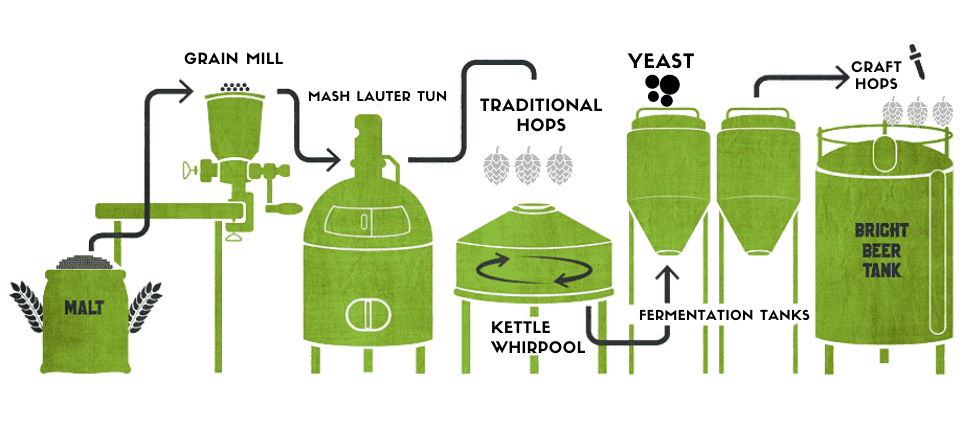
There is a legend that early Egyptians placed malt in a wicker basket to manufacture it, even though historians have search antiquity without finding its actual origin.
Then, they would lower the wicker basket into the open wells of that era. The first time of lowering it into the well was for steeping. Then, the germination process would follow by raising it to the water level.
They controlled the germination rate by adjusting the basket height within the well. With that, workers would lower the basket to a lower temperature level as the heat developed and germination progressed. As such, they can dissipate heat and retard growth. They would simply raise the basket to a higher level to speed up germination.
They then agitated the basket after raising the malt to the well top to keep it from matting. Finally, when it comes to drying, brewers resorted to the natural ways, spreading the malt on the ground to receive a direct sunray. Beverage purposes were the only thought of using malt at this time.
The Birth of Floor Malting
The number of wells limited the malt production of this time. As such, malters then used natural caves and artificial cisterns to increase production. And for centuries, these natural processes continued.
But, in the middle European countries, they discovered the malting process’s next advancement. After that came the rise of the malt requirement and the necessity to create artificial techniques for controlling the humidity and temperatures.
They have malt houses of this time at the bottom of a mountain or hill adjacent to a stream, which provided low-temperature water through gravity. These malt houses had mortar or stone floors with huge stone walls. The only ventilation means were the small windows set.
They would receive barley into these malt houses and be ready for steeping by dropping it into the deep cisterns. Next is depositing it for germination on the malt house’s stone floor. Heat would generate as the growth. People would then spread the malt towards the front of the room in a thin bed after they have shoveled it from the pile.
The process would accomplish any further cooling during the night hours or cool evenings when the workers shoveled the malt’s first thin layer forward to another spot of the ground, allowing it to fall in a light shower and throwing it into the air. They would then apply the proper moisture by using the old method of sprinkling can.
These brewers would move the bed to the forward end of the floor from the rear through the shoveling process to control temperature. With that, they would deposit each successive steep from the steeping cistern onto the floor, going down the floor length with its predecessor.
Where Do Brewing Malts Come From?
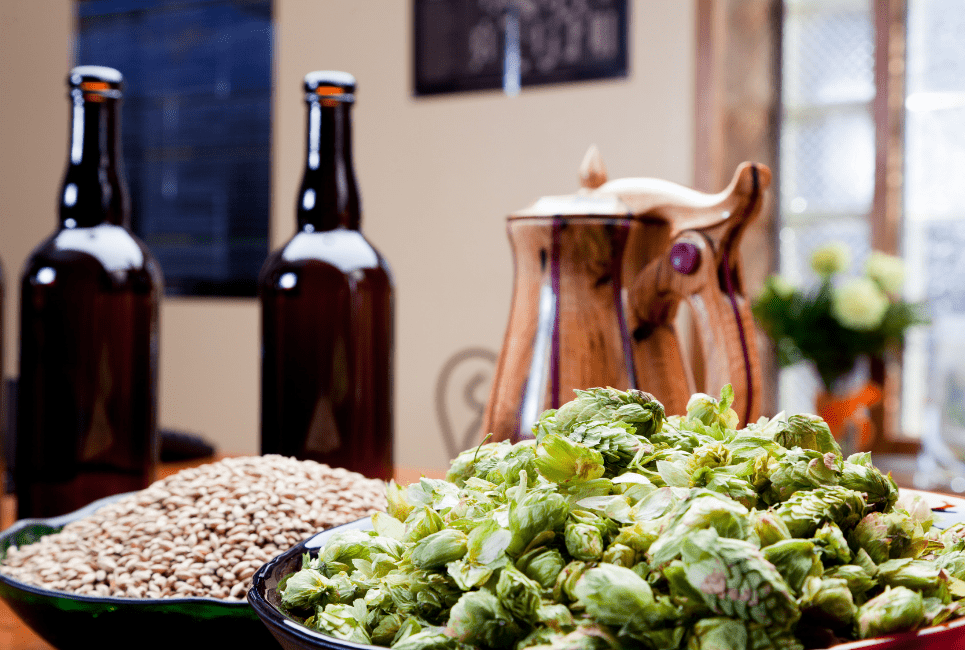
Brewing malts come from mostly barley. It is a process that begins by germinating barley grain in a process known as malting. This process includes immersing barley in water to help the grain to sprout. Once this happens, you can dry it out to halt the process as soon as the grain begins to grow.
As beer is mainly made from malted barley, a process is needed to ferment the sugars extracted from this malted barley.
The malt, in general, is usually referred to as maltose and malted barley – basically, anywhere you can derive sugars from to create alcohol. Here is a list of some of the common regions where malts derive from and some defining factors on each.
American
American brewing malts have a variety of flavors, aromas, and color profiles. These malts can range from fairly neutral tastes used in American lagers and pale ales to more bold flavors that you’d find in rye malts or darker malts.
American malts can be spicy, sweet, and used to add robust flavors while being light on the tongue and easy on the nose.
German
A bit bolder than American malts, German malts make up a lot of wheat beers that you will find as they are full-flavored malts. These malts have a fuller, deeper flavor and are usually amber to dark amber, depending on the type of malt.
Heavy caramel flavors can be found within most German malts, as plenty of robust enzymes are found within this region’s malts.
British
British malts are ideal for full-flavored ales. These malts can add a sweeter toffee flavor to pale ales, porters, and bitters. British region malts are also known for their chocolate varies that can add in a roasted chocolate flavor that is delightful on the palate and on the nose.
These can lend up some robust beers, mostly found with the darkest amber colors to almost black. British malts can also be found in older style English ales and more traditional lagers served in pubs.
Belgian
Belgian grain malts provide full-flavored lagers, including Belgian ales and European wheat beers. These are aromatic malts that can have a powerful malt flavor and rich colors.
From roasted caramel flavors to complex dark colors, you will defiantly get an eclectic experience for all of your senses when drinking a Belgian malt-style beer.
Misc.
All other malts that don’t fall into a specific region can be considered miscellaneous malts. These malts can be smoked, may be used in steeping, and are truly unique.
Color profiles can range from amber to dark amber, light honey colors, and even reddish ales. Flavors can include honey, toasted flavors, smokey flavors and can be used in Lambic beers.
Modern Malts Brewing
Centuries witnessed the prevailing of these basic early malt house principles. However, people continued to search for new techniques to increase production. The major malting process changes occurred with the advent of electrical power and steam.
Types of Brewing Malts
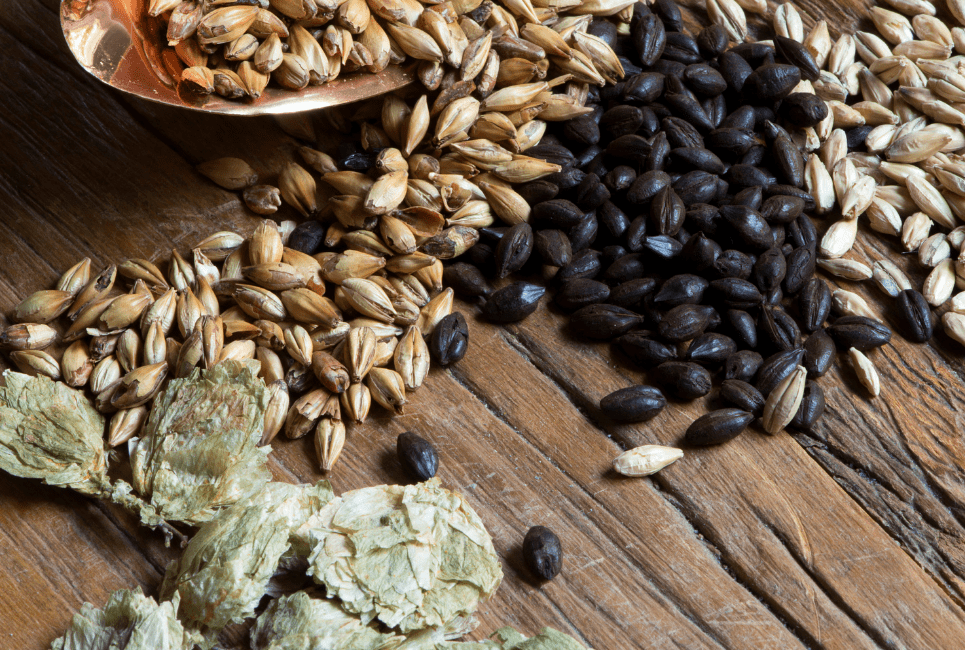
As a grain, professionals can convert malt into sugar. Then, yeast consumes that sugar to create alcohol, a process known as fermentation. Likewise, the malt comes from grain that then becomes beer.
As a homebrewer, you have several malt types you can use. There are two broad categories of these malt types, malts required to be mashed (all-grain brewing needed) and malts that can be steeped (perfect for extract brewing).
Roasted Malts
Any grains or malts roasted to an extremely high degree are roasted malts. They are delicious, bready, deep, and dark. You can mash them for all-grain or steep them for extract brewing before adding plenty of color and complexity in pretty low quantities. Here are a few varieties:
- Distaff cousins like pale chocolate and de-bittered black malt. People use steep roasted malts for extract brewing or all-grain when mashed.
- Kiln-coffee malt
- Weyermann® range of Caraga® malts (Check out our complete Weyermann Malt Review)
- Roasted barley, chocolate malt, or black malt (also known as patent malt)
You don’t have to be like some homebrewers who get gun shy about roasted malts. While they are delicious, you have no worries about roasted malts going overboard: you would typically use 10 percent of it (average five-gallon batch will require one pound). It will be pretty hard to go wrong when you stay below this amount.
Check out roasted malts here.
Toasted & Kilned Malts
These malt types boast aromatic malts, special roast, amber, and biscuit. In addition, they contribute unique flavor with a five-gallon take half a pound; people typically use them in low quantities.
- Tangy flavor and impart a slightly reddish, darker color.
- Another light option is victory malt that sits between amber and biscuit and has traits of both.
- Amber and brown malts are the same toasted malts, but amber does not have a pretzel-like flavor, and brown is more bready or toasty and darker.
- Aromatic malt is maltier and darker, while biscuit malt has a light saltine cracker flavor.
Adjunct Grains
These are starchy, unmalted things that people know as cereal grain. Essentially, homebrewers typically use things like potatoes and pumpkin as well.
- Rice
- Potatoes
- squash/pumpkin
- terrified wheat
- Maize (corn)
- Flaked oats and flaked barley
- Starchy grain or vegetable
Adjuncts are not like crystal malts that have sugars available. Thus, people cannot steep them for extract brewing. And since adjuncts are not the same as malted grains, they don’t have enzymes, and brewers don’t need to mash them with malt base to extract their sugars.
Caramel & Crystal Malts
Generally, homebrewers use crystal malts to add color and sweetness to all-grain and extract brews since there are steep. As a general rule, darker crystal malts add nuttiness and sweetness to their sweetness, while brewers will have the motto “sweet’ in the lighter-colored crystal malts.
There are dextrin malts at the extreme light end. These dextrin malts add dextrins that bring a thicker and body mouthfeel. However, crystal malts are anything with the label of caramel or crystal .
- Caramel/Crystal 10: This malt has a very light color with a honey-like sweetness that is a great choice for your lighter homebrews.
- Caramel/Crystal 40: This malt is great for all beers that need a strong crystal malt, and it’s a great go-to if you are stumped on which type of malt to go for. This malt has a perfect caramel flavor and will add a caramel color and sweetness to your beers.
- Caramel/Crystal 120: This malt will give your beers a bittersweet caramel taste and aroma to your beers. You can use this malt in smaller quantities as heavier concentrations may be too much for your standard homebrew beers.
Base Malts
What makes up most of all-grain beer’s grist is the base malts , with astounding, frankly, variety. These malt types get their name from the corns’ formation on the barley stalk. The region they malt or grow it, or the variety impact impart their names.
- British malts are biscuit-like, bready, and maltier, while American base malts tend to be generally fairly and mild neutral.
- High-kilned malts are responsible for the European malty, dark lagers and their characters endear them to base in some ales. Prime examples are Vienna and Munich malts.
- Rye and wheat malts are non-barley based malts.
- Barley malts include mild ale malt , Munich malt , Vienna malt , Pilsner malt , pale malt , and more.
Malts grown in the European climate have an elegant, clean character since they are made from Continental barley. The delicate, soft maltiness character of pilsner malt typically defines pale larger. The roof high-kilned malts are the base since brewers heat their malting process end to a higher temperature. Mild ale is also in this same category. A more malty, toasty flavor of their darker colors lends them lighter base malts.
American Pale Malt
Pale malt is a general base for brewing grain beers. It is very high in diastatic power and contains a neutral base malt. This type of malt is commonly used in American Lagers or Ale-style beers.
- Wheat Malt: Wheat malt is used to make wheat beers and Weizen beers. This type of malt has small amounts of aid in head retention without altering its flavor. This type of malt is usually combined with a high enzyme and imparts a malty
- Rye Malt: Rye malts are used for German-style beers and American pilsners. This malt gives the beer a spicy, dry flavor and has a different pale-yellow color.
- Vienna Malt: Vienna malt retains wonderful enzyme power that can support about 40 percent rare or specialty malts. Vienna malts are traditionally used in pilsners, as they are rich, aromatic, and give the beer a deep amber color.
- Munich Malts: Munich malts are darker and can be used to create a very robust flavor. This type of malt is ideal for dark or amber lagers, especially for German bock beers.
- Carapils Dextrin Malt: With a full body and mouthfeel, the Carapils malt is known for its great foam stability and sweetness that comes with it.
- Victory Malt: This is a nutty-tasting malt that adds orange highlights to your beer. It’s ideal to use in ales, porters, dark lagers, or any type of beer that will require a stronger malt taste.
- Special Roast: This complex malt will offer up a strong sourdough or biscuit flavor that ranges from toasty to nutty. This is ideal for darker beers and has a distinguishable orange and reddish color to it.
- Chocolate Malt: Also known as roasted black malt, this malt will add a glorious dark color and bring a pleasant roasted flavor to your beer. This nutty and deep flavor will do well in coffee-forward or cocoa-flavored beers due to the bold tastes.
- Roasted Barley: Roasted barley malts are made from unaltered grain, with a much stronger flavor than sweeter coffee-forward malts. This malt will add in a lot of colors and has chocolate or black barley flavor to it.
- Black Barley: Black barley malt is coffee like which will go great in porters or stouts. It has a delightfully strong flavor, just like your cup of morning coffee right when you wake up.
- Black Patnetin (Highly roasted black malt): This is the darkest of all malts and almost has a roasted charcoal flavor. This malt is great to be used in very dark beers due to the strong flavors and aromas.
German
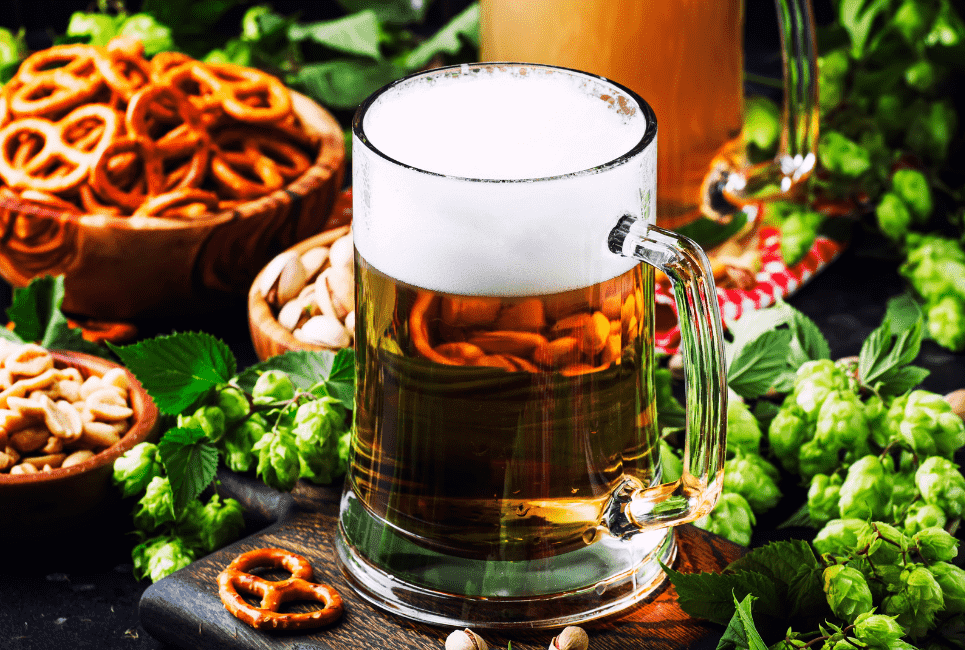
- German Pale Malt: This malt makes up about 80 percent of the wheat beers and Weizen beers you can find. This malt is great for German yeast strains and contains a full flavor that you will recognize in any wheat beer.
- Weizen: Another popular malt type in German beers, Weizen malts, are blended with pale malts to make a perfect addition to German wheat yeast strains for a full flavor.
- Wiener/Vienna Malt: Vienna malts are going to get you a fuller, deeper malt flavor and aroma. These beers will look like a light amber color and will definitely up the body in your beer.
- Munchener/ Munich Malt: Munich malt is a great pale malt that retains plenty of enzymes to create a full, malty flavor in your beer. These beers are traditionally golden in color and lightly caramelized.
- Crystal / Med. Caramel: This malt will add color and sweetness to European lagers, Vienna, and Oktoberfest lagers. This malt provides plenty of body and sweetness for specialty edition beers.
- Carafa Special: This special malt has been made by de-husking barley to help reduce its harsher flavor. It instead brings in a nice roasted flavor that is authentic in German dark lagers.
- German Acidulated Malt: This malt has lactic acid bacteria that is used for adjusting the pH levels of your beer.
- German Melanoidin: This is an aromatic and darker malt that makes your beers reddish brown. It has a great body and fullness.
British
- English Pale Malt: This is a full-bodied malt that many brewers prefer for its steady taste.
- English Crystal: This is a full English malt with plenty of color and flavor for bitters, pale ales, and porters. It has a toffee-sweet flavor and aroma to it.
- Chocolate Malt: Chocolate malts are used for classic British porters and even some brown to mild ales and stronger stouts. These are versatile malts that have a smooth character and delightfully roasted flavor.
- Brown Malt: This malt will impart a roasted flavor and bitterness to beer. This is a more old-world-style malt used in more traditional brown ale, stouts, and porters.
- Amber Malt: Amber malts make your beers taste warm and almost coffee-like. These are great in Scottish ales and are wonderful in pale and brown ales.
Belgian
- Belgian Pilsner: This malt is a great addition to malty beers and is perfect for lagers, Belgian ales, and wheat beers.
- Aromatic: Aromatic malts are perfect for adding in plenty of distinct flavor and colors. It’s great for ales and lagers and has a rich color.
- Belgian Special: This is the darkest of Belgian crystal malts. It has a strong roasted caramel color and flavor and can make beers appear to be a ruby red to dark brown. It is a dark and complex malt that is known for its almost raisin-like flavors.
- Biscuit Malt: Biscuit malt is delightfully toasted and great in lagers and ales. It will give a beer the flavor of toasted bread.
- CaraVienne: This is light caramel sweet malt that will give you a fuller beer flavor. While it may smell heavily of caramel, it won’t give you too much caramel flavor that it is overpowering.
- CaraMunich: This malt is a caramelized German Munich malt known for its reddish color and strong taste fuller and gives off a rounder texture. These malts are used in most Oktoberfest beers or specialty beers.
Miscellaneous
- Rauchmalt: This is a smokier malt that has been smoked in various ways using all different types of woods. This should be used in amber to dark amber beers or even porters due to the strong taste.
- Honey Malt: This malt has a great honey-like flavor and aroma that is perfect for malty sweetness within a beer. Honey malt has a beautiful red color and provides a warm toasted flavor with honey in the foreground.
- Peated Malt: Using peat over slow-burning coals, this malt is perfect for enhancing the flavors of Scottish ales. It is considered a smoked wood malt and should be used in darker beers such as stouts or lagers.
- Raw Wheat: Raw wheat has more starch and haziness to the beer. This is beer in its most raw form.
Brewing Malts Vs. Malt Extract
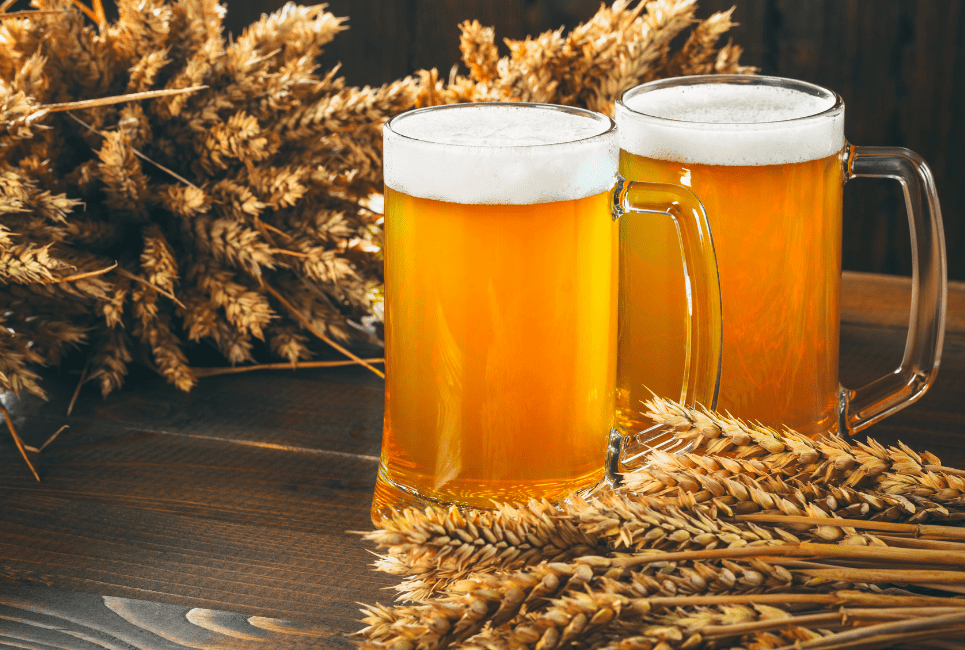
Brewing malts are a dry powder that is added at the start of your brew. Malt extracts are liquid with a consistency like honey. Malt extracts can come in a pre-hop style if you want to make your brewing process more manageable.
Liquid and dry brewing malts are not interchangeable within a recipe due to water and sugar contents.
While a brewing malt is dry, it contains no water. You will need more water per brewing malt compared to a malt extract that will require less water as it has water in it. A pound of liquid extract and a pound of dry malt will have entirely different sugar contents as well.
How to Use Brewing Malts
You will want to add in your brewing malts when you make your starter for your homebrew. You do this by bringing your water to a rolling boil, stirring in your malt extract, and allowing this mixture to boil for about ten minutes.
After your wort cools down, you can pour the resulting beer and add it to your full wort.
Then, all you’ll need to do is put in your yeast and allow the mixture to ferment. Adding in your malt is an essential step as it will help your mixture derive sugars and allow it to ferment properly.
How to Choose the Best Brewing Malt for You?
There are many different brewing malts to choose from that will add depth and warmth to your homebrewed beer. The first thing you will have to do is determine what kind of beer you plan to make and what types of flavor and aroma profiles you want to incorporate into your beer.
Once you know that, you can research the various types of malts and determine which one goes best with what you want to make.
How to Get Started with Brewing Malts – Essential Kits
The fact that you can make them in batches gives you the biggest benefit of making homemade malts. Another benefit is that you can adjust your home brewed malts flavors.
If you are ready to start your home brewing journey, you will need some vital kits. This section will show you some quality kits for your malt brewing ventures. Continue reading to find some of the best home brewing kits in the market today!
Craft the Brew Brown Ale Beer Kit – Best Variety

When it comes to getting an amazing beer-making kit that will give you some of the tastiest malt types like dry cider, toasty Irish stouts, or dark brown ales, you will have the perfect use with Craft A Brew Brown Ale Beer Kit .
Serves around one gallon of lip-smacking malt at parties that each flavor produces. If you are a beginner homebrewer, you will appreciate the brewing method with the product’s straightforward instructions as a quality starter kit. The complete kit includes a thumb clamp, transfer tubing, racking cane, funnel, a carboy, and more!
Pros
- Easy-to-follow guide
- Fresh tasting malts
Cons
- Shipment and quality control issues
Be more than a beer drinker; be a beer maker! This craft beer kit turns beer lovers into beer brewers and gives you all the independence, experience, and fun that comes with brewing your own home beer.
BrewDemon Craft Beer Brewing Kit Signature Pro – Best for Fermenting

A conical fermenter comes with the BrewDemon Craft Beer Brewing Kit Signature Pro , similar to what larger breweries typically use. As such, you will find this kit to have everything you need if you want to learn how to make authentic malts. In addition, the unique kit eliminates any nasty byproducts and produces clearer malt and beer.
Brewers can make two gallons of smooth and light fermented malt and beer. Essentially, the kit has one-quart bottles, a temperature gauge, a stopper, a unique venting system, and more. This kit can make an excellent malt fermentation kit for novice and beginners alike as a whole.
Pros
- Pro-conical fermenter
- easy to clean
- Quick fermentation time
Cons
- The plastic fixture can crack with time
There's no better way to describe the only 2-gallon conical fermenting system. This innovative system allows you to make craft-brewed beer like the pros but in smaller batches.
Northern Brewer – Essential Brew – Perfect For Advanced Brewers
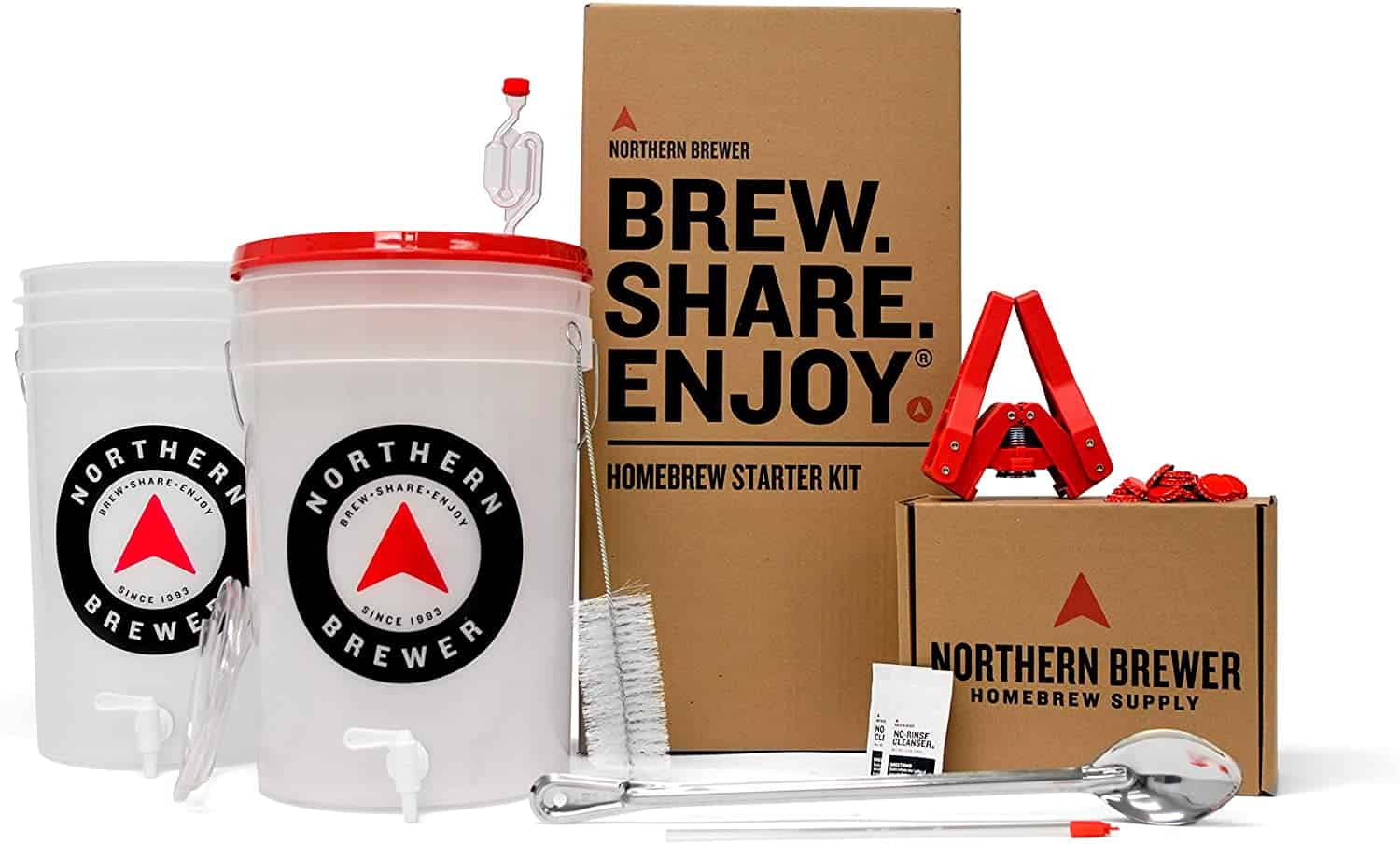
Northern Brew Essential Brew is a great brewing kit for any serious brewers out there. The kit can yield around five gallons of fruity and fresh-squeezed herbal IPA beer. Any brewer can enjoy their caribou slobber version if they are looking for more complex flavors.
You will get your standard home brewing equipment with each IPA beer-making kit. However, this upgrade has extra tools, including an immersion wort chiller and an eight-gallon Mega pot. It also includes a translucent bucket and a fermenter without a siphon for easier bottling and transferring.
Pros
- rapid chilling
- Upgraded equipment with full kit
Cons
- Quite expensive
- Does not include bottles
Mr. Beer Complete Beer Making Starter Kit – Ideal for Novices

Mr. Beer Complete Beer Making Starter Kit will be the perfect kit for you if you want the easiest means of starting your homebrewing journey. The product has shatter-proof bottles, a two-gallon fermenter, and more to make it easy for homebrewers to use. The brewing extract can come with the kit contains all-natural malted hops and barley.
As a DIY homebrewing kit, Mr. Beer can yield a caramel, sweet golden ale perfect for making cheese fries. Generally, homebrewers won’t have to deal with any complicated process using this kit, as it has step-by-step instructional directions on how to make malt or beer.
Pros
- The product has reusable bottles
- Lightweight, compact fermenter
Cons
- There can be a leak in the keg
Mr. Beer’s Premium Gold Edition complete home brewing kit provides aspiring brewers with patented brewing equipment and high-quality ingredients that simplify the homebrewing process.
Mr. Root Beer Home Brewing Kit – Good For Root Beer


Everyone knows that alcoholic beer is not good for kids. That is why Mr. Root Beer Home Brewing Kit will get you covered if you want your kids to enjoy something sweet. With the kit, you can brew non-alcoholic, creamy beer. It boasts funnel, caps, and four one-liter bottles.
In addition, there is also a package of yeast, flavor crystals, and root-beer extract for flavors. You can whip up any malt recipe with this flavor-packed root beer. Ultimately, enjoy making your malts with your little ones through its easy instructions.
Pros
- Complete kit with bottles
- fast brewing
- easy to make
Cons
- May leave a yeasty aftertaste
With the Mr. Root Beer kit, you will be able to produce two gallons of delicious old-fashioned root beer in as little as three days!
The Best Brewing Malts Recipes to Get Started
You must become a maltster if you want to take your homebrew venture to another level. A maltster creates the malt used in brewing by adding a little heat and sprouts whole grain. Essentially, you have all the skills and equipment required to make your malt from scratch if you can read a thermometer, have a large baking pan, and a kitchen oven.
Using Whole Barley
You would be getting to the “home” in your home brewing adventures with this step. You will also save some money with it. First, however, ensure that they have not treated your whole barley with pesticides or other harmful chemicals that can cause sickness when buying it.
The grain with the husk on is the whole barley. Since the husk is critical for the mask brewing lautering process, you cannot use pearled barley of other de-husked barley types. Pet shops that sell bird seed and country stores that cater to ranchers are likely sources of whole barley.
You can also find an ideal bargain by buying some bushels directly from the farmers at harvest time in August and September if you live in a place where they grow these grains. We recommend you test one pound to ensure it is a viable seed capable of germinating before buying a large amount.
By following the procedure we outline below, you must see around 90 percent of the grain sprouting. You can try a different brand or another supplier if it is not viable.

The Germinating Process
The main ingredient needed is raw barley. For the all-barley malt homebrew gallon you propose to make, use two pounds of whole barley until you start malting. Remember, you will see significant improvement in your extraction rate with practice. After that, you can adjust the amount with your desired definite gravity.
You can start the process by washing the barley thoroughly in clean water to eliminate the trash that floats to the surface. Next is to drain the barley and put it in a covered container with enough water to reach inches above your grain Leave the grain to soak for about eight hours.
Then, drain it and allow it to stand for another eight hours without water. You should start seeing whitish bulges at the tips of the barley grain after the final eight hours of soaking. These whitish bulges are the emerging roots.
Kilning

Put on a 100 degree to 125 degrees of heat source and place the large baking pan on it to make pale malt. Do this for 24 hours or till the malt has about 12 percent moisture, original test pound of about 18 ounces.
You can use an oven with the pilot light on it as your heat source. The top of a gas refrigerator is also perfect for it. You will also have a temperature of around 140 degrees to 160 degrees for the final drying process.
The malt will have an initial amount of about 16 ounces, and the absence of debris like husk dirt will compensate for the malt’s moisture weight. Dry the malt slowly by turning it every half hour, thereby protecting the starch-converting enzymes by raising the temperature over time.
The lower temperature of 100 degrees to 125 degrees will dry the entire malted wheat. You will have a slightly sweet taste and crunchy bite to the finished barley malt.
We will recommend not using the barley malt if you have a glassy interior or rock hard. It means something is not right with germination. As you try another batch, ensure to be careful with the process.
Put green malt on a cookie sheet in a 212 degrees oven for an hour to make crystal malt. You can also leave it until golden brown grains. Homebrew has brown color and sweetness from crystal malt without the roasted malts’ burnt flavor characteristic.
Recipe

Here is an English-style ale with various homemade malts incorporated in it.
English Ale – All-Grain With 2 Gallons
Ingredients
-
- 1/3 cup priming sugar
- Dry Muntons ale yeast
- 8 grams. Fuggle hop pellets for 90 min.
- ½ tsp. gypsum
- 1 oz. dark roasted malt
- 6 oz. toasted Munich-style malt or crystal malt
- 7 oz. malted corn or malted wheat
- 50 oz. pale malt
The Process
Water at 127 degrees and mash into 6 quarters of water. After that, rest at 122 degrees as you allow 45-minute protein rest. Ensure to maintain the temperature for 90 minutes after raising it to 151 degrees.
Sparge with water at 170 degrees as you mash out at 167 degrees. Next is to add your hops and leave them for about 90 minutes to boil. Pitch yeast, aerate, and cool to room temperature. Use priming sugar to bottle it when fermentation is complete. Then leave it for about two weeks before sampling.
Don’t be discouraged if you notice low content in the first few batches. As you get more experience at malting, it will go up. Then, you will have a truly homemade malt without planting your hops or barley and complete satisfaction.
The Best Brewing Malt Options
Rite Brew Dry Malt Extract
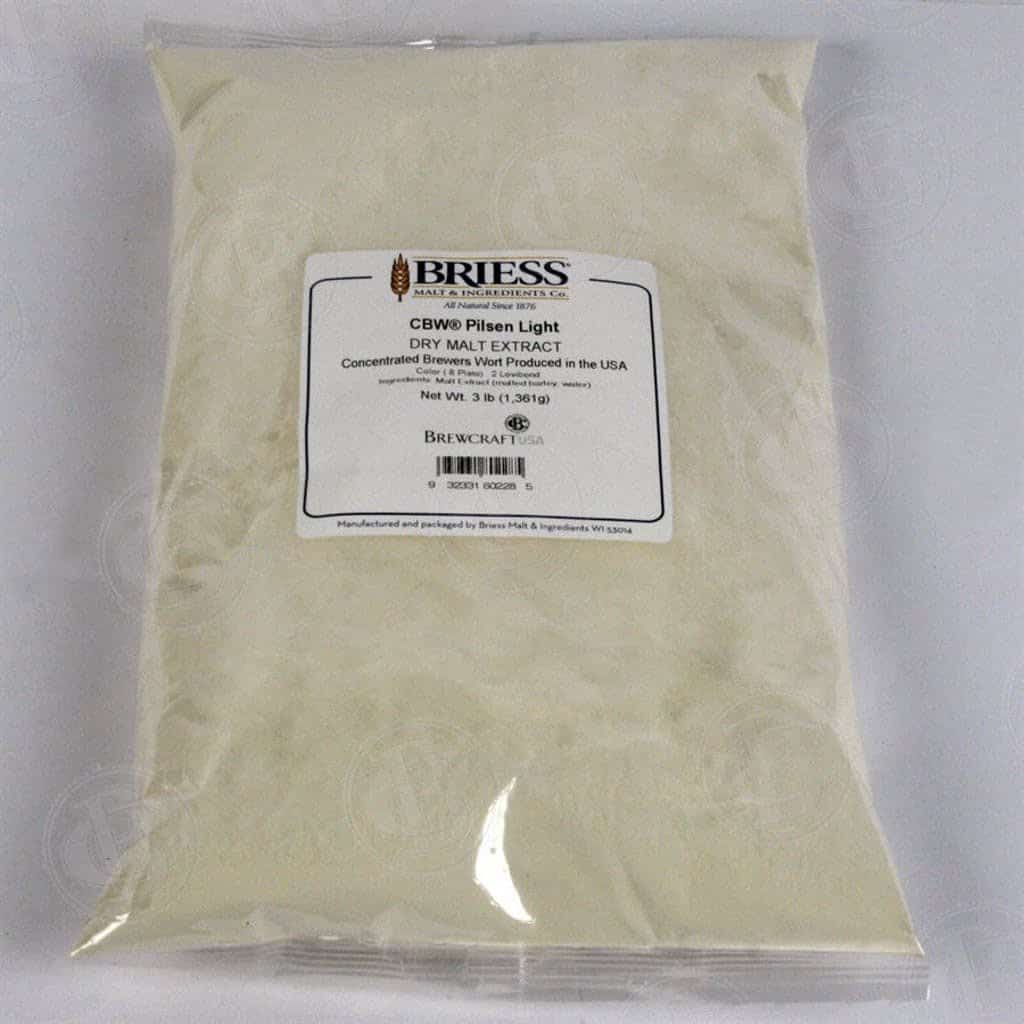
Rite Brew has made an excellent American Pilsen light dry malt extract in a three-pound bag. This is 100 percent malted barley extract made with Pilsen malt and carapils malt.
- Type: American Pilsner
- Size: three-pound bag
- Best For: American beers, light pilsners
- Flavor: Light, golden toasty
- Price: Less than $20
This is ideal for light-colored Weisens or beers with specialty grains that need a lighter malt. All you are getting here is malted barley that you need to add water to create delicious home brews.
Pros
- Light flavor
- Light amber color
- From the USA
- Pure malt extract
Cons
- It may be too much for some
- A little pricey
A malted barley extract that is 100% pure and consists of Pilsen and carpels malt.
Crushed Malted Barley
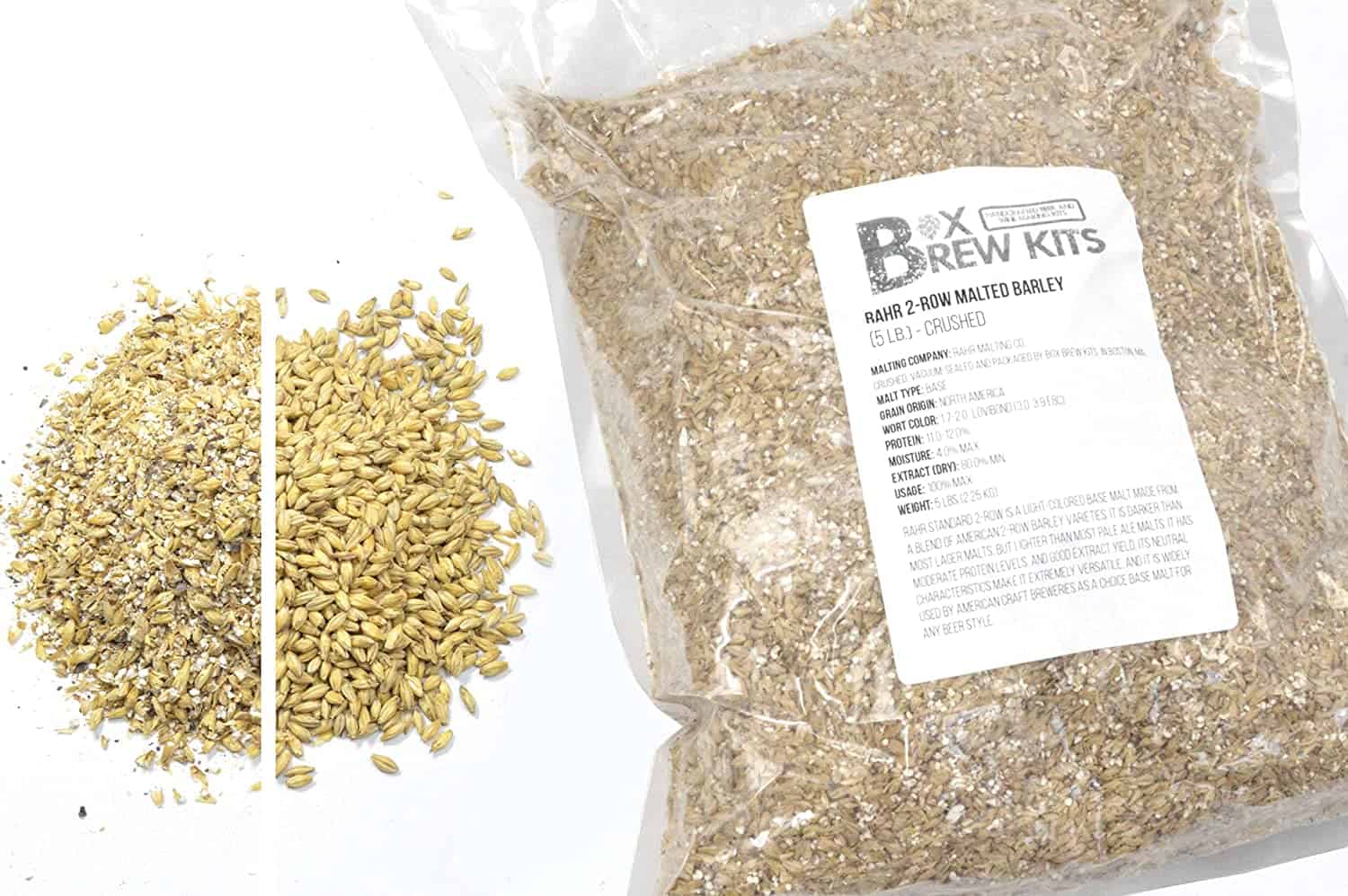
Box Brew Kits has made some wonderfully crushed malted barley in a five-pound bag that has been vacuum-sealed for freshness.
- Type: Malted barley
- Size: Five-pound bag
- Best For: American beers, German beers
- Flavor: Very malty
- Price: Less than $30
This is a bag of crushed 2-row base malt that has been milled to standard grain mill speciation’s so you can expect consistent results. This is a great base malt for all types of brewing needs.
Pros
- Comes vacuum sealed
- Perfectly crushed for consistency
- Milled to standard grain specifications
- You get five pounds
Cons
- Maybe too much grain for some
- It may have too much of a malted taste for some
Brewer’s Malt
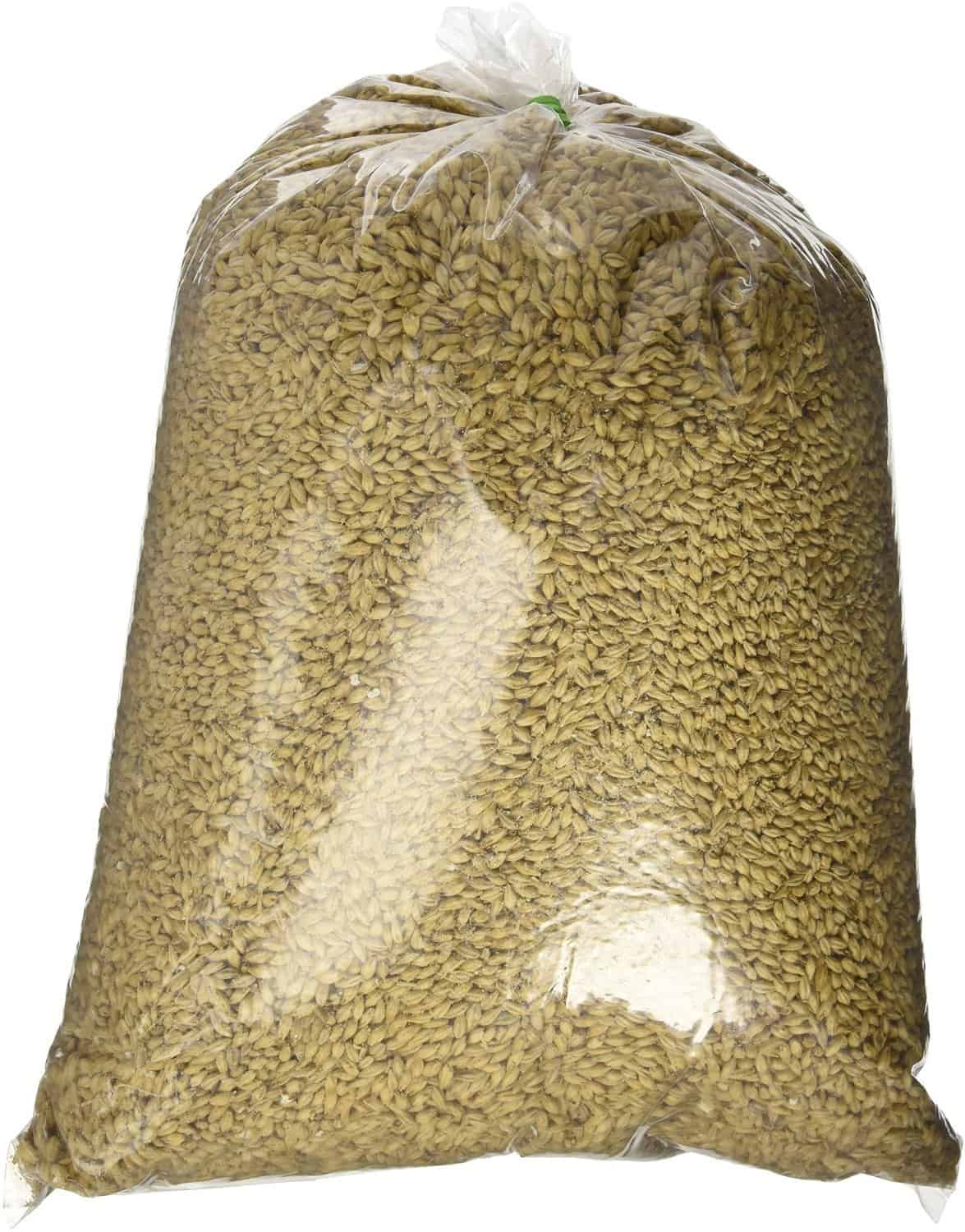
Briess has put together a 10-pound bag of brewer’s malt that is ideal for home brewing. This grain bag is one of the most commonly used and makes a perfect base malt in all types of grain or partial mash brewing.
- Type: Brewer’s Malt, whole grain
- Size: 10-pound bag
- Best For: A great base for all kinds of beers
- Flavor: Smooth, effervescent, malt
- Price: Less than $25
This grain yields a bit of a higher extraction rate. A 2-row grain is smooth and high in enzymes, so you can infuse this in a single step. This grain has been made in the United States.
Pros
- Made in the United States
- Excellent base grain
- Higher extraction rate
- Smooth and high in enzymes
Cons
- It may be too much for some
- Grain is not crushed
2-Row is a base malt for all beer styles and provides a smoother, less grainy Flavor than 6-row brewers malt. The malt is also higher yield than 6-row brewers malt but has a slightly lower protein than 6-row brewers malt.
Caramel Brewing Malt
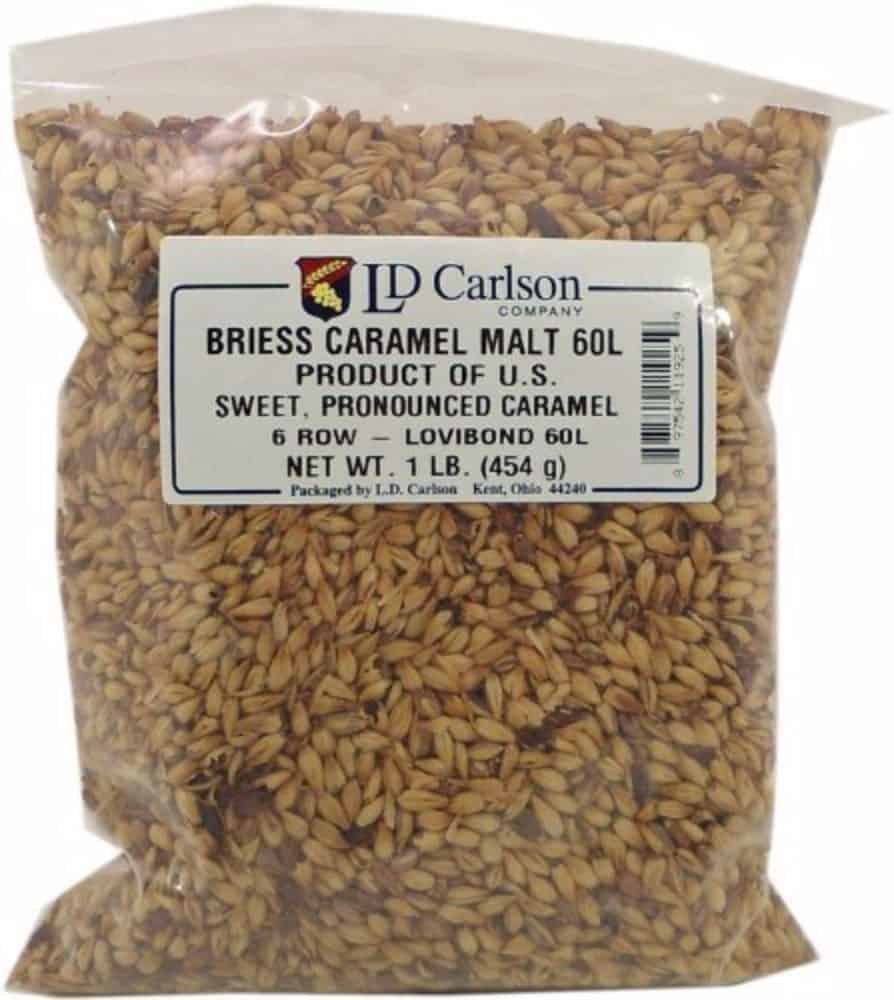
A United States blend, this one-pound bag of caramel brewing malt comes to you in the whole grain, so it is not crushed.
- Type: Caramel Malt
- Size: One pound bag
- Best For: Lagers, sweeter beers
- Flavor: Light and sweet
- Price: Less than $10
This malt will provide an excellent, rich golden color and will promote the taste of golden caramel throughout your brew. It has a well-balanced sweetness to it that won’t overpower your stronger brews.
Pros
- Light sweet flavor
- Golden color
- Whole grain
- It comes in a one pound bag
Cons
- It may be too little for some
- It may be too sweet
The flavor is sweet with pronounced caramel characteristics. Contributes deep golden to red hues.
Chocolate Brewing Malt

This Briess 2-row chocolate brewing malt is ideal for making stouts, lagers, and even some specialty darker brewed beers. This grain comes to you in a one-pound bag, and it is the whole grain, so it is not crushed.
- Type: Chocolate Malt
- Size: One pound bag
- Best For: Lagers, dark beers, stouts
- Flavor: Chocolate
- Price: Less than $10
This is a dark roasted malted barley bag, so it will not make a great base malt, but instead, it will make a great specialty grain to add to your beer.
Pros
- It makes a great specialty grain
- Will add plenty of depth to your beer
- It comes in a whole grain
- It comes in a one-pound bag
Cons
- It may be too sweet for some
- It won’t be suitable for a base malt
Briess 2-Row Chocolate malt imparts the flavor of rich, roasted coffee, and cocoa white producing a brown color.
Rye Malt
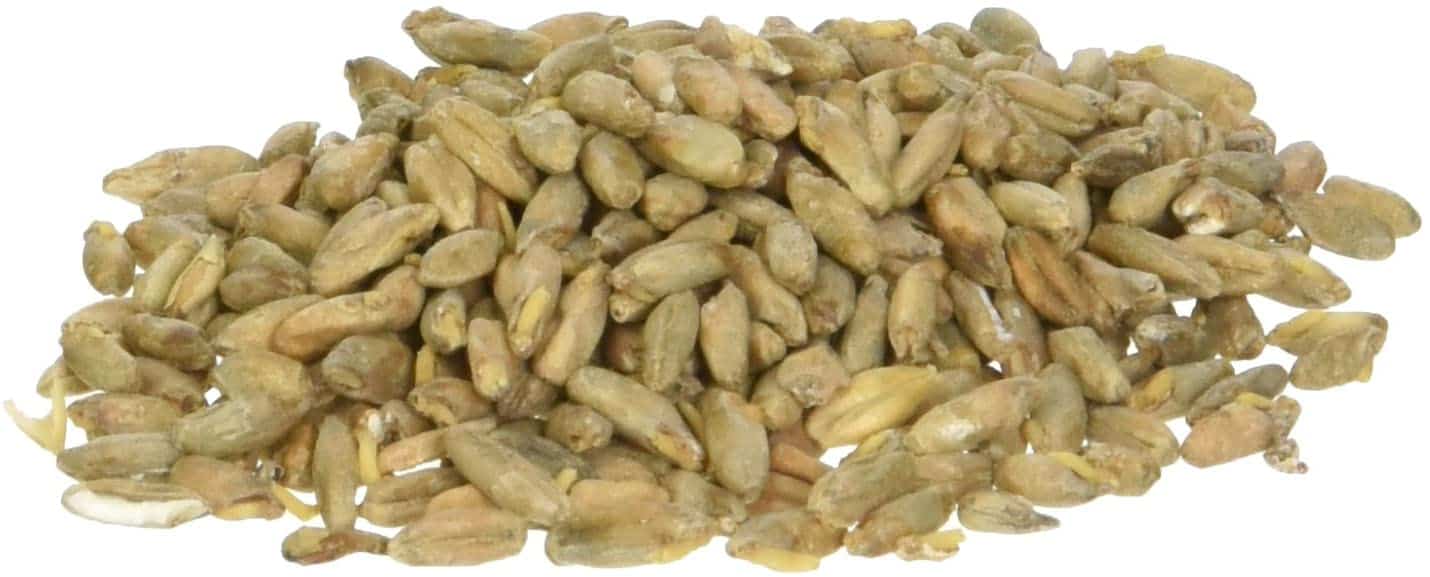
A deliciously spicy malt, this unique rye malt comes in a fruity and effervescent flavor. It comes in a ten-pound back which is plenty to try in several different brews.
- Type: Rye malt
- Size: 10-pound bag
- Best For: IPAs, lagers
- Flavor: Spicy and effervescent
- Price: Less than $25
You will need to crush up your grains before using them as this comes to you in whole grain. This bag is extra sealed with heavy-duty plastic to ensure freshness to your brews.
Pros
- Good base malt
- It has a spicy taste
- It comes in whole grain
- It comes in a ten-pound bag
Cons
- It may be too sharp for some
- You will have to crush your own grain
Has a unique fruity, spicy flavor used in the production of rye beer and whiskey.
Munich Malt
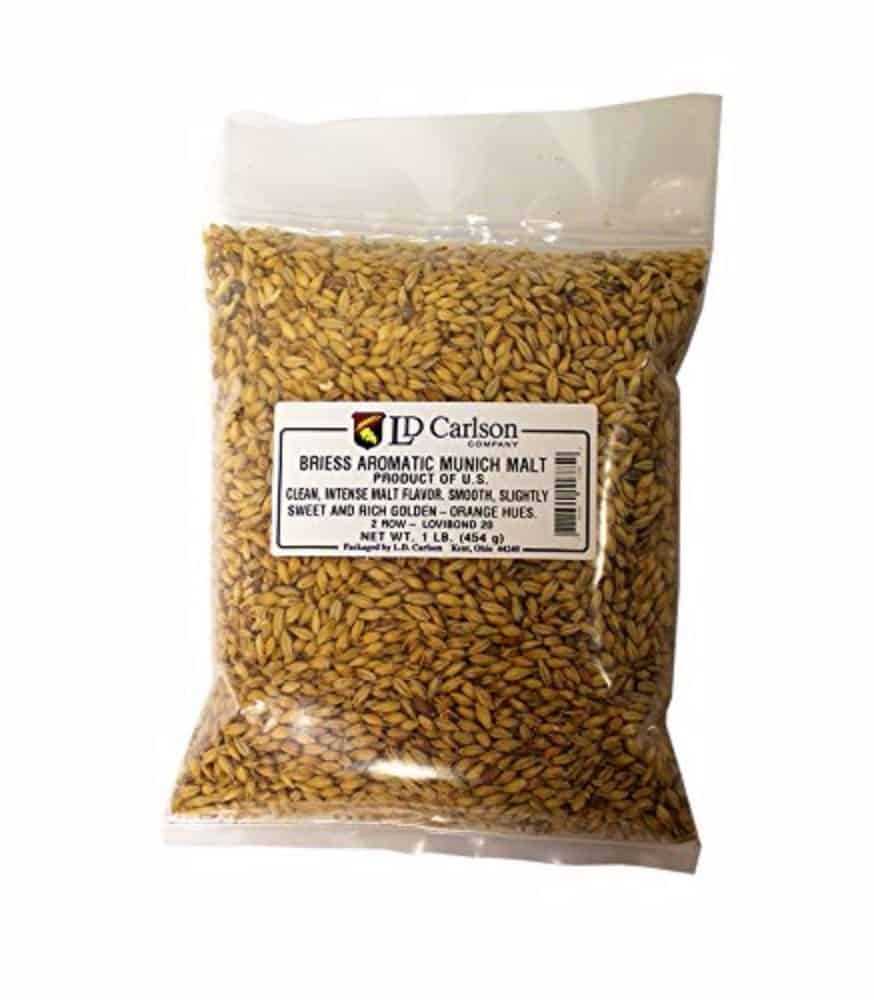
A delicious 2-row Munich malt, this grain is very smooth and has a clean and sweet finish. It will make your beers lightly sweet, all while maintaining that rich malty flavor to them.
- Type: Munich malt
- Size: one pound bag
- Best For: German bock beers, stouts
- Flavor: Sweet and smooth
- Price: Less than $15
It is a product of the USA and has a rich golden to orange color.
Pros
- Munich malt
- Very smooth
- It comes in a one-pound bag
- Whole grain
Cons
- You will have to crush your own grain
- A bit on the sweet side
European-style 2-row Munich Malt that delivers rich malty flavor to your traditional German lagers, or any beer that benefits from the increased malty flavor.
Safety Tips for Brewing Malts
Many homebrewers learn the hard way regarding homebrewing safety. Some of them wear shorts and flip-flops without taking caution about the dangers around them.
That is why you need to know that it is dangerous as cooking soup. Meaning that you can sustain second-degree burns that could be an unpleasant thing Except you are inattentive and careless, this result is not likely.
Therefore, watch out for some of these crucial safety gear and precautions in your homebrewing.
- Using Open-Toed Shoes: As we mentioned earlier, many homebrewers cannot remember what they dropped or spilled on their feet. After dropping a carboy with their toes cut open from the exploding glass, many had to switch to boots. Don’t let smashed and burns toes be part of your homebrewing experience. Some of these steel-toe boots will be ideal for you.
- Climbing Ladders in Gravity Setups: Don’t try to do this because it is an easy and quick way to fall, scare or burn yourself.
- Not Testing Gravity of Malt Before Bottling: Homebrewers refer to this situation as “bottle bombs.” Ensure your malts have fully fermented before capping the bottles to prevent the explosion. This case is similar to grenade shrapnel, and it can turn into a big mess. You can prevent this from happening by using a cardboard box for your bottled malts to soften the blow.
- Unaware of Bleeding Pressure from Kegs Before Opening Lids: Many new homebrewers know nothing about CO2 pressure when they start kegging. That is why you need to bleed the built-up gasses inside the kegs under pressure before trying to open the lid. The fly can fly off with significant force into your face if you fail to bleed off the pressure.
- Not Cleaning Spills: You can have a big slip and fall with a small spill. It can lead to falling, getting your arm or leg swelled up, and becoming infected with any disease. Therefore, clean up any spills.
Our Top Recommendations
Our team has collected some of the homebrew advice and tips from various sources with many years of homebrewing experience. Ensure to follow them to achieve success with your homebrewing journey.
General Homebrew Tips
Here are some general homebrew tips to follow:
- The ingredients will be of the same quality as your malt or beer quality. Always go for the best and freshest quality possible. Ensure that your hops are green and nice and the extract is within any specific dates.
- Bulking priming your malt can be a simple addition to your bottling process since doing this will add greater consistency and control to your bottle’s priming sugar level.
- Choose a bottling bucket or fermenter without any tap if you can.
Ahead of Brewing Day
Before you start your homebrewing journey, ensure to:
- Read and understand the recipes before you start brewing. Ensure to start only when you have all the ingredients ready.
- Ensure to put some of the sanitizers you intend to use in a spray bottle for easy sanitation during brew time.
- Don’t use bleach as your sanitizer because it can be hard to rinse out or even ruin your batch if it contacts your wort’s maltose.
- Have the habit of sanitizing anything you see with your beer after the boil.
Pitching Yeast
Follow some of these for pitching yeast.
- Put the whole brew pot onto a tub or sink of cold water when cooling a partial boil. It is faster, and you only need to change the water a few times.
- If you are new to homebrewing, you will find dry yeast packets perfect since they are pretty easy to use and have a high cell count.
Improving Fermentation
To improve your malt fermentation, you will need to:
- If you intend to use a two-stage fermentation, use a bottling bucket since you will only need a hose length to the rack into the secondary.
- Put your fermenter in a big water container to cool it and prevent temperature fluctuations if you want to control fermentation temperature.
Frequently Asked Questions
Let’s discuss some of the questions concerning malt brewing and what other things you need to know.
Question: What Kind of Malt is Used in Beer?
Answer: Malted barley processed to yield a range of fermentable maltose sugars are those that brewers recommended. These are chocolate or roasted malts, Munich malts, Vienna malts, pale malts, and lager malts.
Question: Which Malt Can Be Steeped?
Answer: Best briess malts for steeping are caramel malts, extra special malt, victory malt, and carapils malt.
Question: Can Victory Malt be Steeped?
Answer: Yes, you can steep victory malt since it has no diastatic power. A perfect candidate for this malt is nut-brown because of its flavor effects.
Question: What are the different types of malt?
Answer: Most malts are made from barley, but you can find some malts in wheat and rye. From this, you can find hundreds of different variations in malt profiles, flavors, and aromas.
Question: How do I choose a malt?
Answer: It’s best to choose a malt that will complement your beer, so first, find out which type of beer you’d like to make to incorporate the appropriate malt.
Question: How do you choose a malt for beer?
Answer: By flavor profile and aromas.
Question: What kind of malt is used for a lager?
Answer: Usually, German or American malts are ideal for lagers.
Types of Brewing Malts Guide – Final Thoughts
So, there you have it, all you ever wanted to know about brewing malts to help get you on your brewing way. With so many different types of malts from different regions, you can easily find your ideal malt to go with your very own homebrew to create something truly delicious.
We have given you all you need to know about the types of brewing malts, and if you are ready, we recommend using Craft A Brew Brown Ale Beer Kit because it offers the premium homebrewing kit you need to get started.
In addition, it is a viable investment since the product has reusable equipment. Apart from this added convenience, it can also yield up to a gallon at a time.
Finally, though it has no bottles and has a relatively small brewing capacity, the kit provides a seamless and fast extract process.
As you get set to brew your malt, ensure to refer to some of the best tips and tricks discussed above. Remember to check out some of the safety tips to have a pleasant experience with every brew.
Did you find this article helpful? I hope you did. Do you have any experience working with brewing malts and homebrewing?
I would love to hear what you have to say about it. Please feel free to share your thoughts and comments below!


